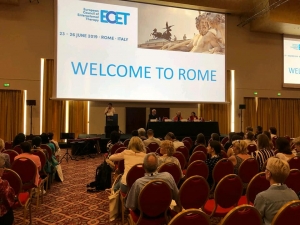Fragments of the information presented to the ECET:
- June 2019
After opening the event, the ECET board presented the programme and welcoming the participants.
- Luisa Salani, Italy – Caring gestures and thoughts from the voices of nurses – about a study and its phases: Starting point – A qualitative phenomenological study : 340 nurses – Method and data analysis – Caring for the other: dedicated time, paying attention, respecting other, trying to establish relationship with patient, satisfying the patient’s needs, being concerned with the emotional decision etc.
- Taking time for caring gestures and words – in the daily practice nurses have to decide to which kind of patient dedicate more time
- Paying attention – is the first caring action. Nurses should have an open mind..
- Acting with delicacy, Touching patient’s body – a wide range of caring actions emerged from nurses’ stories
- Being on the alert: nursing surveillance – while I was giving the medication I spoke to him ( patient) and I could feel a strange way of breathing , so I asked himself if he was having problems.
- Impacting on context to facilitate the act of caring.
Caring from Italian nurses’ perspective: it is a practice carried out through competent actions and willingness to intentionally take care of the patient. It involves an international and prompt care. Comparing our results with international studies. Caring generates caring – to support the ethical tension that nurse caring requires in contexts exposed to continuous suffering and to the cure of incurability.
- How research is helping or should help caring / taking over nurses. Ermellina Zanetti,
- Experience a relationship of closeness with nurses
- To be informed
- Receive a continuous attention ; “caring for” behaviors that indicate to patients that nurses “care about” them.
Nurses – patient interactions: Virtually all nurse-patient interactions could be categorized into one of the following areas:
- Getting to know each other
- Translating (explain, informing etc.)
- Expert compassion (includes genuine concern ad a “ connection”)
- Patients’ concerns focus more on the availability of a nurse to attend to their specific requests than on “closeness’ with a nurse
- When nurses are readily available to “care for” patients this can potentially result in patients believing that nurses “care about” them
FROM NURSING SCIENCE TO PATIENT NEEDS: A LONG JOURNEY
Unversita degli Studi di Firenza, Mario Del Vecchio
Some fundamental steps:
- Nursing science
- Nurses capabilities and skills
- Nurses number
- The roles that nurses play and the tasks they perform
Four priorities in FNOPI ( 2017) document (Italian document):
- To expand the scope of practice
- To practice in a safe environment:
- To practice in full partnership with physician and other health professionals/ high quality in multi-professional team
- To be open to and ready for the future: in a changing world the choices of the professional community should be more “pulled by the future” than “pushed by the past”.
Profession’s strategies – a wider perspective:
- In designing their strategies nurses, as any other professional, tend to adopt a strict disciplinary perspective
SIMPOSIUM
Pier R. Spena ( FAIS Italy) attended and held an welcome speech session, with entero-stoma therapist Natascia Tonarelli and Sarah Rusell ( Clinical Exercise Specialist)
Me + recovery programme
- Recovery after stoma surgery – what does recovery look like ? exercise guidelines and research; what do nurses say? What do the patients say?
- Ostomate , own experience surgery diverticulosis , no information about exercises for abdominal ;
Importance – confidence
What advice do you give your patients about physical activity and exercise after stoma surgery?
Confidence spiral: urgery, rebuilding confidence, increased activity, no loss muscle, less pain, more confidence.
What are the benefits of physical activity?
How much physical activity should you do?
Percentage of respondents NO meeting guidelines for physical activity (150 minutes of moderate activity per week).
Physical Activity after surgery with hernia
Patient Comments 2018:
- Need more advise about abdominal exercises “I wish I’d been advised and how to prevent them”
- I am scared to do exercise in case I get a hernia
- Exercises is so important in the recover process, But it is never discussed.
Do you think patients should be given specific information about physical activity? Patients answers – yes
Guidelines – Patients should be advised to commence core abdominal exercises 3 – 4 days post surgery
Exercise and cancer – exercise is safe – before, during and after treatment – it helps to combat side effects and reduces risk of recurrence, may help body fight cancer 7 aid treatment.
Suggested guidelines:
Everyone is different – people with stoma can make any exercise they want, Appropriate core /pelvic floor exercises , Regulate intra-abdominal pressure ( IAP)
Goals of me recovery (Sarah Rusell speaker)
- Return to normal activity , work and life soon
- Rebuild confidence – physical and mental
- Core muscle and pelvic floor function
- Empower – enable – focus on positives
- Increase physical activities
3. Natascia Tonarelli – Enterostomal therapist – Cisanello Hospital Pisa
Event in Pisa with the support of Convatec for patients for exercises, patients do exercises all together
After finding out about the “Me+ recovery” – patients have learned movements, started to do exercises etc.






